Chapter 10a: Communicating Sustainability in the Fashion Industry
“People just aren’t thinking anymore about where their clothes come from”
--Stefan Voigt, Fast-West Textilrecycling
Objectives
By the end of this chapter, students will be able to:
- Describe the role of communication in promoting sustainability in the fashion industry and how it can improve consumer trust and influence behaviors.
- Identify the major sources of environmental impact in the fashion industry and discuss strategies to mitigate these impacts.
- Explain the differences between traditional and sustainable fashion practices, including their environmental impacts and consumer perceptions.
- Evaluate the effectiveness of different sustainable fashion practices, such as ethical sourcing and recycling.
- Discuss the importance of ethical fashion marketing and how it can influence consumer choices and drive demand for sustainable products.
- Recognize the benefits and challenges of sustainable fashion and how these practices fit into broader sustainability models.
- Utilize a variety of strategies for reducing waste in the fashion industry, including upcycling and closed-loop systems.
- Identify the roles of various stakeholders, including corporations and NGOs, in fostering partnerships to promote sustainable practices in the fashion industry.
Introduction
Fashion is a significant part of our daily lives, reflecting personal identity and cultural values. Advances in technology have led to an increase in clothing production. The industry's rapid growth and reliance on fast fashion have led to substantial environmental and social impacts. Clear and accurate communication in the fashion industry can help address consumer concerns, enhance conservation efforts, and mitigate waste. This chapter explores strategies for communicating about the excessive growth of fashion, which includes accessories such as shoes and purses, covering key areas including the importance of sustainable fashion, ethical practices, and the role of stakeholders in promoting sustainability. Keep in mind that the strategies and theories discussed can be applied to other materials in the textile industry including pillows, sheets, cushions, and more.
Why Sustainable Fashion is Important
Americans created 17 million tons of textile trash in 2018, 81 pounds per person. Of the 17 million tons, 11.3 million tons were dumped and 2.5 million recycled. The graphic below illustrates textiles waste management from 1960-2018, with recycling rising since 1980, combustion with energy recovery growing since 1980, and landfill use increasing every year.

Though this figure only depicts the USA, similar tendencies are seen worldwide. Average clothing fiber consumption has almost quadrupled in 20 years, from 7kg to 13kg per person. That's total apparel fiber—at least 15% gets left on the cutting room floor and becomes textile waste. Ecologist Dr. Mark Browne found that synthetics lose microplastic particles with every wash, entering the food chain. Synthetics decompose down slowly in landfills and may never break down. The population increase from 1992-2013 along with global garment fiber consumption can be seen below. Global garment fiber consumption has always been greater than population, but it soared in 2007, dropped, then has increased every year following 2010:
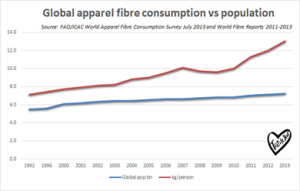
In less than 20 years, U.S. textile waste has climbed 78%, while the waste stream has only grown 10%. Most textile waste is dumped in landfills. Compared to other materials such as plastics, wood, glass, and paper/paperboard, textiles change in tons generated and change in tons per capita generation are significantly higher. The chart below shows textiles’ change in tones per capita generation is 54% and change in tons generated is 78%. The second highest is plastics, with less than half of both percentages.
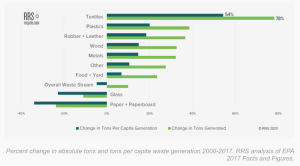
Environmental Impact
According to the United Nations Environment Programme (UNEP), the fashion industry is responsible for 10% of global carbon emissions and nearly 20% of wastewater. [4] The fashion industry is one of the largest polluters globally, contributing to water pollution, carbon emissions, and waste.
Water Consumption and Pollution
The fashion industry is a major consumer of water, with processes such as dyeing and finishing being particularly water-intensive. The World Bank estimates that textile dyeing contributes to 17-20% of global industrial water pollution. [5] That makes fashion the second biggest consumer and polluter of water in the world. Also, 500,000 tons of microfibers are released into the ocean each year from washing clothes, the equivalent of 50 billion plastic bottles. Moreover, 93 billion cubic meters of water – enough to meet the needs of five million people – is used by the fashion industry annually, contributing significantly to water scarcity. Around 20% of industrial wastewater pollution worldwide originates from the fashion industry. [6] Textile industries dump water iwhich contain metal, mercury, and smell badly into rivers and lakes, makingthe water not potable for humans or fish. As a result, nearby areas become uninhabitable, which can lead to war and mass migration. The dyes from fabrics pollute waters, which kill populations of fish, put fishermen out of work, impacts the fish industry, kills agriculture, causes health hazards, and affects other crops. For example, the cadmium, chromium, and lead found in crops (e.g., ginger) transports through water to other countries. [7]
Carbon Emissions
Waste Generation
Fast fashion's emphasis on rapid production and disposal has led to an increase in textile waste. The Environmental Protection Agency (EPA) states that 85% of all textiles go to the landfill each year. [9] The clothing industry sales have doubled between 2000-2022. Western companies continue to negotiate lower prices so clothing keeps getting cheaper but fashion industries have a value of more than 2.5 trillion $ USD. [10]
The fashion industry is highly profitable. They employ over 75 million people worldwide. Clothing production doubled between 2000 and 2014. While people bought 60% more garments in 2014 than in 2000, they only kept the clothes for half as long. [11] The industry also has significant social implications, including labor rights violations and poor working conditions. Brands must communicate their efforts to ensure fair wages and safe working environments for their workers. [12] Textile workers, primarily women in developing countries, are often paid low wages and forced to work long hours in appalling conditions. The impacts on health arise from pollution for locals. In April 2013, the Rana Plaza Factory collapsed, killing over 1100 workers. [13]
How Businesses can Communicate about Sustainability in Fashion
Fashion companies have the potential to connect with audiences more personally than industries that previous chapters have discussed (e.g., energy, food, water). Since customers may follow brands on social media, brands can use these platforms to share stories about their sustainability efforts, engage with consumers, and respond to inquiries. [14] Ethical marketing involves transparency about production processes and the environmental and social impacts of products. Brands can build trust by providing detailed information about their supply chains and the steps they are taking to become more sustainable. [15] They can also implement educational campaigns that inform consumers about the benefits of sustainable fashion and drive demand for eco-friendly products. These campaigns can include information on the environmental impact of clothing, the importance of ethical labor practices, and tips for sustainable living. [16]
Evaluating Sustainable Fashion Practices
Money drives the industry—if “green” products sell, companies will go for it. If sustainability standards cost money, companies will avoid it. Shutting down factories will just cause more pollution, waste, so shutting them down is not the solution. Less developed countries have unique ways of working around standards. More developed countries are interested in cutting costs and claiming otherwise. Below are ways that businesses can communicate that their clothing is socially and environmentally conscious:
Ethical Sourcing
Ethical sourcing involves procuring materials that are environmentally friendly and produced under fair labor conditions. This practice reduces the environmental footprint and ensures the well-being of workers. This resulted in the ACT Initiative, where businesses promise to only work with factories that meet standards on wages, safety, and environment. [18]
Recycling and Upcycling
Recycling involves breaking down old clothes to create new materials, while upcycling repurposes old items into new products. These practices can significantly reduce waste and resource consumption. [19]
Below are two statements about boosting a brand in fashion. In addition to describing what they have to offer, notice they also describe their company’s values.
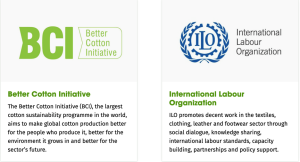
Examples of How Companies Express Repairing and Recycling Fashion
Patagonia’s Environmental Activism
Patagonia has long been a leader in sustainable fashion, promoting environmental activism and ethical practices. [21] The company uses recycled materials, advocates for conservation efforts, and encourages consumers to buy less and recycle more. Below is an example of an ad that says “don’t buy this jacket” over a photo of a blue jacket. On the right it says “common threads initiative.” Then it says the following:
Reduce. We make useful gear that lasts a long time. You don’t buy what you don’t need. Repair. We help you repair your Patagonia gear. You pledge to fix what’s broken. Reuse. We help find a home for Patagonia gear you no longer need. You sell or pass it on. Recycle. We will take back your Patagonia gear that is worn out. You pledge to keep your stuff out of the landfill and incinerator. Reimagine. Together we reimagine a world where we take only what nature can replace. [22]
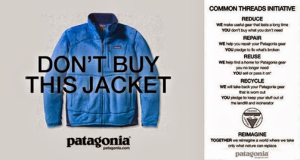
H&M’s Conscious Collection
H&M launched its Conscious Collection to promote sustainable fashion. The collection features clothing made from organic and recycled materials, and the company aims to use 100% sustainable materials by 2030. [23] Its website says Our products are created with a little extra consideration for the planet: at least 50% of each piece is made from more sustainable materials, like organic cotton or recycled polyester. The only exception is recycled cotton which, for quality reasons, can only make up 20% of a product. [24]
Levi’s Water<Less Initiative
Levi’s has implemented the Water<Less initiative to reduce water usage in its production processes. Since its inception, the initiative has saved over 3 billion liters of water. [25] On the water.org website, it has a quote from its co-founder Matt Damon: "At Water.org, we apply the best thinking from the private sector, the public sector, and the financial markets—wherever breakthrough ideas exist—to solve the water crisis…With partners like the Levi’s® brand, we move closer to ending the global water crisis, creating a better life for future generations." [26]
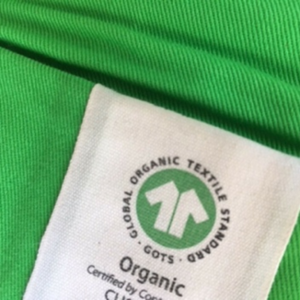
The Fashion Pact is the largest CEO-led initiative for sustainability in the fashion industry. Every Fashion Pact member is committed to working towards our shared vision for a nature-positive, net-zero future for fashion. See https://www.thefashionpact.org/?lang=en for more info. Below are two images of and statements by CEOs on why they joined the Pact: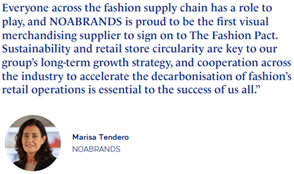

Good On You is used by millions of shoppers, major retailers, and tech platforms to compare how well brands address their impacts on people, the planet, and animals. Here’s how we rate brands on the issues that matter most to you. Good On You’s brand ratings give you the power to see through the greenwashing on everything from greenhouse gas emissions and water use to worker safety, living wages, and animal welfare. How does it work? We bring together publicly reported information on the most critical sustainability issues, and then present it in clear and accessible ratings anyone can understand. Below is an example rating of Chanel and Patagonia side-by-side. Chanel received 2/5 on planet, people, and animals, overall “not good enough” due to “not taking adequate steps to eliminate hazardous chemicals in its supply chain.”[28] Patagonia received 4/5 on “planet and animals” but 2/5 on “people,” with an overall rating of “good” with the explanation: “uses lower impact materials and has good policies to ensure animal welfare.” [29]
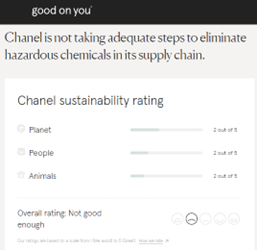

Other Actions We Can Take
We see additional steps that companies can take to remove some of the social and environmental risks that are commonly part of the fast-fashion model:
- Establish guidelines and methods for developing clothing that are readily recyclable or reusable. A Sustainable Apparel Coalition index measures clothes and footwear’s whole life-cycle effect.
- Develop novel fibers to reduce environmental impact on garment manufacture. The Walmart Foundation granted approximately $3 million to five US institutions in 2016 to explore textile production sustainability and efficiency.
- Encourage low-impact clothing care. Energy is wasted washing and drying clothes in hot or warm water or for too long. Clothing manufacturers and merchants may assist customers choose eco-friendly cleaning methods that make clothing last longer.
- Foster mechanical and chemical recycling technology development. Apparel manufactures find mechanical recycling fibers shorter and lower-quality than virgin fibers. As technology progresses, chemical recycling may improve.
- Increase supplier labor and environmental standards and enhance supply chain transparency. Software startup EVRYTHNG and packaging manufacturer Avery Dennison are tagging apparel so buyers can track its production across the supply chain.
- Guide and support suppliers in fulfilling new labor and environmental requirements and hold them responsible for performance gaps. Walmart has pledged to obtain 70% of its goods directly from suppliers from plants with energy-management plans by 2017. The firm gives providers software to investigate ways to save energy and other resources. [30]
- Check out websites such as https://donatestuff.com/ for areas where you can donate or have them pick clothing up for you.
- Find an app that traces sustainable garments and footwear. With access to reliable and verifiable information, we are all empowered to take steps towards a more circular, less wasteful economy.
- If you don’t want your clothes, sheets, or pillows:
- Donate, swap, or give away (such as on Facebook)
- Replace with second hand or upcycled clothing
- Look for Global Recycle Standard, and OEKO-TEX
- When doing laundry, fill the machine, use a low temperature, and air dry your clothes. Consider a recyclable laundry bag such as Guppy Friend Washing Bag or the Cora Ball to keep microplastics out of the wastewater when washing clothes. [31]
Conclusion
The fashion industry faces significant environmental and social challenges, but effective communication and sustainable practices can drive positive change. As individuals we can also take better care of the textiles we own and pay more attention to what we do with them. We don’t have to stop loving to shop or get rid of lots of clothes; we just need to appreciate what we have—if we buy less, we waste less. By considering what happens to textiles in the long run and promoting transparency, engaging consumers through social media, and implementing educational campaigns, textile industries can enhance their sustainability efforts. Ethical sourcing, recycling, and closed-loop systems are vital practices that can reduce the industry's footprint. As consumers become more aware of these issues, the demand for sustainable fashion will continue to grow, fostering a more sustainable and responsible industry.
[1] Textile Waste | Nebraska Recycling Council | Waste Nothing. (2024, January 5). Nebraska Recycling Council. https://nrcne.org/textile-waste
[2] The numbers on textile waste. (2016, November 24). Textile Beat. https://textilebeat.com/the-numbers-on-textile-waste
[3] Press Release: Textile Recovery US Roadmap - Recycle.com. (2020, June 30). Recycle.com. https://recycle.com/press-release-textile-recovery-us-roadmap
[4] United Nations Environment Programme (UNEP). (2020). Sustainability and Circularity in the Textile Value Chain. Retrieved from https://www.unep.org/resources/publication/sustainability-and-circularity-textile-value-chain
[5] World Bank. (2019). How Much Do Our Wardrobes Cost to the Environment? https://www.worldbank.org/en/news/feature/2019/09/23/costo-moda-medio-ambiente
[6] Drew, D. (n.d.). The Apparel Industry’s Environmental Impact in 6 Graphics. World Resources Institute. https://www.wri.org/insights/apparel-industrys-environmental-impact-6-graphics
[7] Wednesdays for the Planet | The Clothes We Wear. (n.d.). https://www.genevaenvironmentnetwork.org/events/wednesdays-for-the-planet-the-clothes-we-wear
[8] Ellen MacArthur Foundation (EMF). (2017). A New Textiles Economy: Redesigning Fashion’s Future. Retrieved from https://www.ellenmacarthurfoundation.org/publications
[9] Environmental Protection Agency (EPA). (2021). Facts and Figures about Materials, Waste and Recycling. Retrieved from https://www.epa.gov/facts-and-figures-about-materials-waste-and-recycling
[10] Wednesdays for the Planet | The Clothes We Wear. (n.d.). https://www.genevaenvironmentnetwork.org/events/wednesdays-for-the-planet-the-clothes-we-wear
[11] Remy, N., Speelman, E., & Swartz, S. (2016, October 20). Style that’s sustainable: A new fast-fashion formula. McKinsey & Company. https://www.mckinsey.com/capabilities/sustainability/our-insights/style-thats-sustainable-a-new-fast-fashion-formula
[12] Fashion Revolution. (2021). Fashion Transparency Index 2021. Retrieved from https://www.fashionrevolution.org/about/transparency/
[13] Wednesdays for the Planet | The Clothes We Wear. (n.d.). https://www.genevaenvironmentnetwork.org/events/wednesdays-for-the-planet-the-clothes-we-wear
[14] Kaplan, A. M., & Haenlein, M. (2010). Users of the World, Unite! The Challenges and Opportunities of Social Media. Business Horizons, 53(1), 59-68. https://doi.org/10.1016/j.bushor.2009.09.003
[15] Brown, T. J., & Dacin, P. A. (2020). The Company and the Product: Corporate Associations and Consumer Product Responses. Journal of Marketing, 61(1), 68-84. https://doi.org/10.1177/002224299706100106
[16] McKenzie-Mohr, D. (2011). Fostering Sustainable Behavior: An Introduction to Community-Based Social Marketing. New Society Publishers.
[17] Boström, M., & Micheletti, M. (2016). Introducing the Sustainability Challenge of Textiles and Clothing. Journal of Cleaner Production, 137, 1-8. https://doi.org/10.1016/j.jclepro.2016.07.056
[18] Wednesdays for the Planet | The Clothes We Wear. (n.d.). https://www.genevaenvironmentnetwork.org/events/wednesdays-for-the-planet-the-clothes-we-wear
[19] Niinimäki, K. (2018). Sustainable Fashion in a Circular Economy. Journal of Fashion Marketing and Management, 22(1), 51-65. https://doi.org/10.1108/JFMM-04-2017-0039
[20] Wednesdays for the Planet | The Clothes We Wear. (n.d.). https://www.genevaenvironmentnetwork.org/events/wednesdays-for-the-planet-the-clothes-we-wear
[21] Chouinard, Y., & Stanley, V. (2016). The Responsible Company: What We've Learned from Patagonia's First 40 Years. Patagonia Books.
[22] Matthews, R. (2024, January 5). Patagonia’s “Responsible Economy” Campaign. Change Oracle. https://changeoracle.com/2013/10/24/patagonia-may-be-worlds-most/
[23] H&M Group. (2021). H&M Group Sustainability Report 2020. Retrieved from https://hmgroup.com/sustainability/sustainability-report/
[24] Conscious - Sustainable Style | H&M HK. (n.d.). H&M. https://www2.hm.com/en_hk/kids/shop-by-concept/conscious-sustainable-style.html
[25] Levi Strauss & Co. (2021). Sustainability. https://www.levistrauss.com/sustainability/
[26] Levi’s® Water. (n.d.). Water.org. https://water.org/about-us/news-press/levis-waterless-campaign/?gad_source=1&gclid=CjwKCAjwzIK1BhAuEiwAHQmU3i_F-D2s_Qe48mdsUm7E1RSul5OpHwMCKii3C8eAYL0u-fguv_FgxxoC4uAQAvD_BwE
[27] Global Organic Textile Standard (GOTS). (2020). The Standard. https://global-standard.org/
[28] Chanel - Sustainability Rating - Good On You. (n.d.). https://directory.goodonyou.eco/brand/chanel
[29] Patagonia - Sustainability Rating - Good On You. (n.d.). https://directory.goodonyou.eco/brand/patagonia
[30] Remy, N., Speelman, E., & Swartz, S. (2016b, October 20). Style that’s sustainable: A new fast-fashion formula. McKinsey & Company. https://www.mckinsey.com/capabilities/sustainability/our-insights/style-thats-sustainable-a-new-fast-fashion-formula
[31] Okamoto, K. (2021, August 5). Your Laundry Sheds Harmful Microfibers. Here’s What You Can Do About It. Wirecutter: Reviews for the Real World. https://www.nytimes.com/wirecutter/blog/reduce-laundry-microfiber-pollution/